The Christian East 843–1648
WYH2010HF Fall 2005
Links
Photios' Myrobiblion, a summary of scores of books which he had read, some of which would otherwise be unknown.
The Confession of Dositheus, patriarch of Jerusalem, also known as chapter 6 of the Acts and Decrees of the Synod of Jerusalem, 1672. This is regarded as the most important synodical statement in modern Eastern Orthodoxy, comparable to the Council of Trent in the West.
An article from the old Catholic Encyclopedia gives an overview of the Synod of Jerusalem from its pre-Vatican II perspective (the article as a whole is on Jerusalem after 1291; the Synod if 1672 is discussed about a third of the way down the page).
Someone has put onto the web a very large part of Kallistos Ware's classic The Orthodox Church, Part II, "Faith and Worship".
An introduction to Orthodoxy from the Orthodox Church in America (recognized by the Russian Orthodox Church in 1970); another REALLY HUGE introduction to Orthodoxy from the archdiocese of America of the Greek Orthodox Church
An Antiochian Orthodox priest in Manchester (it seems to be) writes on Orthodoxy and the Reformation
An Orthodox priest in Austin writes the history of the Orthodox Church after the Crusades
"Oros" or decree on western baptisms, Synod of Constantinople, 1755.
Church and state in Russia, from Emory International Law Review, winter 1998
Georges Florovsky, Ways of Russian Theology
History of Imperial Russia: a big site from Dr. R. Kreuzer, St. Lawrence University, Canton, NY
Website of the Ukrainian Orthdox Church of Canada; if you follow the link to documents / repose of Job, you will find the (devotional? polemical?) story of the Venerable Job, who lived in the early 1600s and is remembered fondly for standing up against Jesuits and other Roman Catholics
A brief history of Russian Orthodox art and architecture from our period
A site with maps of Russia
1. From 843 to 1204
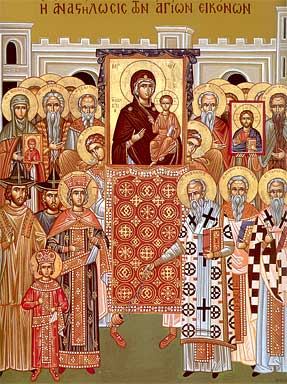 843,
the Triumph of Orthodoxy. The "iconoclastic controversy,"
726-843, had pitted iconodules or iconophiles, who affirmed the
devotional use of icons, against the iconoclasts, who criticized
it as a kind of idolatry. A council at Nicea, 787, affirmed
the iconodule position, but several emperors (especially Leo V and
Theophilus) continued to persecute its advocates. In 842 the three-year-old
Michael III became emperor, and the regent was his mother, Theodora. She
called a synod in Constantinople which definitively affirmed the veneration
of icons. A holy assembly processed to Hagia Sophia Cathedral and restored
the icons to their place. The icon pictured to the right shows Theodora
and her young son, left foreground, and the patriarch and other dignitaries,
restoring an icon of the Virgin and Son at the cathedral.
843,
the Triumph of Orthodoxy. The "iconoclastic controversy,"
726-843, had pitted iconodules or iconophiles, who affirmed the
devotional use of icons, against the iconoclasts, who criticized
it as a kind of idolatry. A council at Nicea, 787, affirmed
the iconodule position, but several emperors (especially Leo V and
Theophilus) continued to persecute its advocates. In 842 the three-year-old
Michael III became emperor, and the regent was his mother, Theodora. She
called a synod in Constantinople which definitively affirmed the veneration
of icons. A holy assembly processed to Hagia Sophia Cathedral and restored
the icons to their place. The icon pictured to the right shows Theodora
and her young son, left foreground, and the patriarch and other dignitaries,
restoring an icon of the Virgin and Son at the cathedral.
The aftermath of 843 was a political and cultural renaissance and a liturgical and monastic revival in the Byzantine Empire. Art historians recognize 843 as the beginning of a new period, marked particularly by new style of church decoration. The period 843-1025 is sometimes called "the golden age of the Byzantine Empire."
Photios (Photius), c. 820-892? He was
the son of well-to-do iconophile parents who were martyred under Theophilus.
A theologian and professor, as 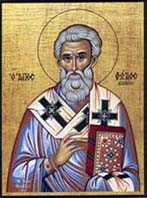 well
as president of the imperial chancery, he was appointed patriarch of Constantinople
in 858, when he was still a layperson. Because of irregularities in the
appointment, the pope refused to recognize him. He was deposed in 867,
reappointed in 878, and deposed again in 886, after which he disappears
from history. By many in the East he is considered the greatest of the
patriarchs; by many in the Roman Catholic Church he has been considered
a usurper and heretic. His achievements include:
well
as president of the imperial chancery, he was appointed patriarch of Constantinople
in 858, when he was still a layperson. Because of irregularities in the
appointment, the pope refused to recognize him. He was deposed in 867,
reappointed in 878, and deposed again in 886, after which he disappears
from history. By many in the East he is considered the greatest of the
patriarchs; by many in the Roman Catholic Church he has been considered
a usurper and heretic. His achievements include:
- Writing homilies, theological and legal works, biblical commentaries, letters, a lexicon, and extended summaries of other works, many of them lost.
- Convening an important synod of 861 which passed several disciplinary canons for the reformation of monasticism and the extirpation of iconoclasm.
- Convening an important synod of 879 which condemned the filioque clause and created a schism with the Church of Rome, and which also recognized the Nicene Council of 787 as the seventh (and, as it proved, the last) of the ecumenical councils recognized by Eastern Orthodoxy.
- Sponsored his former pupil Methodius of Thessalonika, and Methodius' brother Cyril, as missionaries to the Slavs. In Moravia this led to severe friction with Roman church authorities. (Byzantine mission work was often connected with imperial foreign policy.) It also set the stage for the conversion of the Bulgars, Serbs, and, later, Russians.
Michael Cerularius, patriarch 1043-1059. After quarreling with papal legates over the filioque clause and the eastern use of leavened bread in the eucharist (instead of the unleavened bread used in the west), Michael was excommunicated by the legates in 1054. He in turn excommunicated them. This is called the "great schism" between East and West, although most now contend that it was not a schism at all.
Decline, 1025-1204. The Seljuk Turks took most of Asia Minor from the Empire, the Normans took southern Italy and Sicily from the Empire, and northern invaders weakened Byzantium's influence in the Balkans. Poor administration and short-sighted policies undermined the Empire's army and navy. The coinage was debased. Western crusaders invaded the Eastern Mediterranean and established Latin states. The Comneni dynasty (1081-1204) was temporarily able to regain some territory, but the state was fatally compromised.
The sack of Constantinople, 1204, by the Latin Crusaders, is discussed on another course webpage.
2. From 1204 to 1453
The Latin Empire. In 1204, when the Crusaders took Constantinople, they established their own government. Count Baldwin of Flanders became emperor, and the territory of the Empire was partitioned and distributed among the western knights. (The Byzantine emperor and the patriarch ruled in exile across the Bosporus in Nicea.) The crusaders imposed Western feudal law and created a Latin patriarchate, which at its height had 22 archbishoprics, all under the pope's jurisdiction. The Latins were, needless to say, very unpopular, not only among the Greeks but among the Slavs, and their military security was poor. In 1261 a Byzantine commander with a small force near Constantinople was surprised to find the city undefended; he attacked it and captured it. The Byzantine emperor-in-exile, Michael Paleaologus, returned to the city, to the rejoicing of the population, and in Hagia Sophia he was crowned for a second time (the first time had been in exile). He was the founder of the longest-lived Byzantine dynasty, which survived until 1453.
The Latin patriarchate of Constantinople continued to operate in Rome until 1506. After that, titular patriarchs of Constantinople continued to be appointed until 1964.
Pictured: Hagia
Sophia. 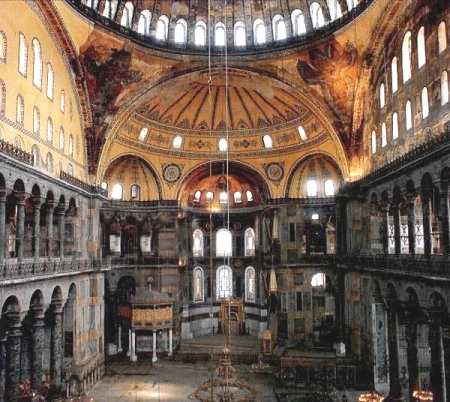
The unionist movement. Fearing another crusade against him, Michael Palaeologus negotiated with the pope, and agreed to unite the Eastern Orthodox Church with the Roman Catholic Church, predominantly on Roman terms. Union was declared at a council at Lyons in 1274, and approved by a pro-Catholic patriarch. It was immensely unpopular among Greeks, and the emperor began persecuting his opponents. A new pope in effect repudiated the union as well, and deposed the emperor. Michael's successor as emperor repudiated the union.
Now the relentless expansion of the Ottoman Empire threatened the survival of the Byzantine Empire. Western powers refused to give military aid to Byzantium unless its church returned to a union with the papacy. Negotiations were renewed from time to time. In 1369 the emperor John V converted in Rome, hoping to win military aid, but it was his own personal conversion, and he was powerless to bring his people into the union. In 1438 the emperor, patriarch, and numerous Greek officials attended the Council of Ferrara, under the presidency of the pope, and discussed the filioque, azyma (unleavened bread in the eucharist), purgatory, and papal authority. In 1439 the council was transferred to Florence. The Greeks accepted the Roman position, and a decree of union, Laetentur coeli, was signed in July. The decree proved unacceptable in Constantinople, and the emperor and his supporters attempted to win support for it there. The union was proclaimed in Hagia Sophia in 1452, despite popular opposition. Nevertheless, western military support failed to materialize.
Until 1439 the metropolitan of Russia had been appointed from Constantinople. In Russian eyes, the emperor and patriarch of Constantinople had forfeited all credibility by renouncing the Orthodox faith in favour of Rome. From now on, Russia appointed its own metropolitan.
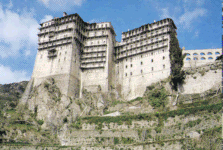 Mount
Athos (Hagion Oros). Located on a
peninsula rising steeply out of the sea in Macedonia, this is the heart
of Eastern Orthodox monasticism. The first monastery was established in
963 by St. Athanasios the Athonite. Further monasteries were founded over
the next two centuries, receiving privileges and land from the emperor.
At its height in 1300, 300 monasteries flourished here. Raids from western
monasteries in the 1300s, and severe taxes and ransoms imposed by the
Ottomans after the 1430s, took their toll. After the Greek war of independence
in 1821, the number of monks increased, but it remained under Turkish
rule until 1913. Today Greek sovereignty is recognized at Mount Athos,
but under the Greek constitution, the community is practically autonomous.
Today there are twenty monasteries at Mount Athos. Today it is barely
possible for a non-Orthodox male to receive a visitation permit to the
peninsula. Females of all species, except cats, are forbidden.
Mount
Athos (Hagion Oros). Located on a
peninsula rising steeply out of the sea in Macedonia, this is the heart
of Eastern Orthodox monasticism. The first monastery was established in
963 by St. Athanasios the Athonite. Further monasteries were founded over
the next two centuries, receiving privileges and land from the emperor.
At its height in 1300, 300 monasteries flourished here. Raids from western
monasteries in the 1300s, and severe taxes and ransoms imposed by the
Ottomans after the 1430s, took their toll. After the Greek war of independence
in 1821, the number of monks increased, but it remained under Turkish
rule until 1913. Today Greek sovereignty is recognized at Mount Athos,
but under the Greek constitution, the community is practically autonomous.
Today there are twenty monasteries at Mount Athos. Today it is barely
possible for a non-Orthodox male to receive a visitation permit to the
peninsula. Females of all species, except cats, are forbidden.
Hesychasm, a mystical tradition of prayer, generated considerable controversy during this period, focused on three synods in Constantinople between 1341 and 1351. Hesychasm refers to : —
- a method of prayer involving controlled breathing and posture, and an exclusion of physical sense data, possibly owing something to Buddhism;
- a spiritual theology defending this approach to prayer, connected with St. Gregory Palamas (d. 1359), and officially vindicated in his lifetime;
- a political party, led by the monks of Mount Athos, who as a result of these controversies gained considerable power in the Orthodox Church.
The central prayer of the hesychasts was the Jesus Prayer, of which a common version is, "Lord Jesus Christ, Son of God, have mercy on me, a sinner."
An introduction to hesychasm, and selected readings, are linked.
The fall of Constantinople, 1453. With
the military expansion of the Ottoman
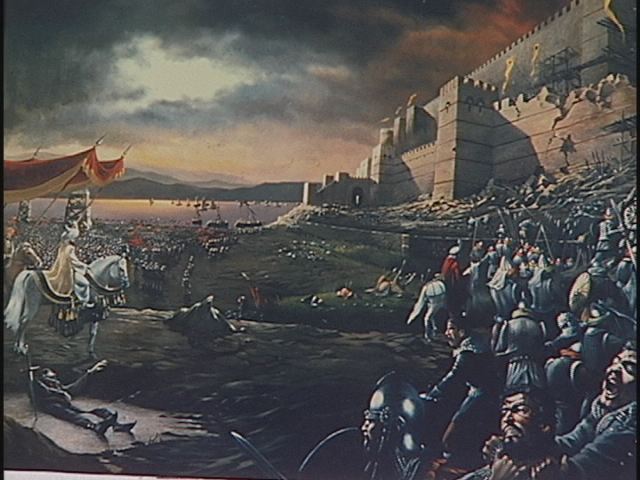 Empire, the Byzantine
Empire had shrunk. By 1430, it amounted to the city of Constantinople
and environs, Thessalonika and environs, and a small state called the
despotate of Morea in what is now southern Greece. In 1452 the sultan
of Turkey, Mohammed II, built a fortress outside the gates of Constantinople.
The following year he brought 200,000 to the siege, and a fleet of 70
ships lay adjacent in the Golden Horn. By contrast, the emperor commanded
7000 troops. Early on the morning of May 29, 1453, the Turks broke through
the gates and violently seized the city. The sultan made it the capital
of the Ottoman Empire. Hagia Sophia was immediately transformed into a
mosque.
Empire, the Byzantine
Empire had shrunk. By 1430, it amounted to the city of Constantinople
and environs, Thessalonika and environs, and a small state called the
despotate of Morea in what is now southern Greece. In 1452 the sultan
of Turkey, Mohammed II, built a fortress outside the gates of Constantinople.
The following year he brought 200,000 to the siege, and a fleet of 70
ships lay adjacent in the Golden Horn. By contrast, the emperor commanded
7000 troops. Early on the morning of May 29, 1453, the Turks broke through
the gates and violently seized the city. The sultan made it the capital
of the Ottoman Empire. Hagia Sophia was immediately transformed into a
mosque.
3. The tourkokratia, 1453-1821
The term refers to Eastern Orthodox Christianity under the jurisdiction of the Ottoman Turks after they conquered the lands of the Greeks and Slavs (Russian Orthodoxy remained independent). Under the Turks (in contrast to the Arabs who held sway elsewhere), Christians were allowed to practice their religion with relative freedom, and the Orthodox Church retained its structures and doctrine. However, with the end of the Roman Empire in the East, its theology of society and culture changed. The patriarch of Constantinople had jurisdiction, under the sultan, over all Christians, regardless of nationality, and synods could be held. But the freedom of the Church was very much restricted, and persecution was always a possibility and sometimes a reality.
Here are a few characteristics of Greek and Slavic Orthodoxy under the Ottoman (Turkish) Empire:
- Liturgy, which had always been important in the East, became REALLY REALLY important, since mission, evangelism, and political involvement were illegal, seminaries and publications virtually impossible, and preaching a bit delicate.
- The most important spiritual centres were the monasteries. Orthodoxy had no monastic orders, as the West did; the most important monastic reality was (and is) Mount Athos, in northern Greece, where many monasteries were built in the same general vicinity. One important form of Orthodox monastic spirituality was "hesychasm", focusing on the Jesus prayer.
- Influences from and reactions against Western Christianity became particularly important.
4. Russian Orthodoxy
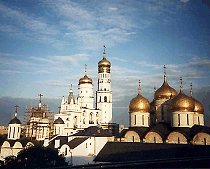 Prince
Vladimir of Kiev converted to Orthodox Christianity in 988 and his nation
followed. The head of the Russian Orthodox Church from then until 1448
was the metropolitan of Kiev, who was appointed from Constantinople, and
indeed who most of the time was a Greek.
Prince
Vladimir of Kiev converted to Orthodox Christianity in 988 and his nation
followed. The head of the Russian Orthodox Church from then until 1448
was the metropolitan of Kiev, who was appointed from Constantinople, and
indeed who most of the time was a Greek.
In the 1220s Genghis Khan swept through Russia which came under Mongol rule by 1240. The Mongol Empire protected and even privileged the Russian Church. Many monasteries were founded. Russia won independence from the Mongols in 1480. The period 1240-1480 is called the Appanage Period in Russian history. Towards the end of the period the power of Moscow was rising; an Orthodox patriarch of Moscow, independent of Constantinople, was first appointed in 1448.
The first tsar (caesar) was Ivan IV "The Terrible", who ruled with great ruthlessness 1547-1584, and left the country in shambles. In church affairs, by the Synod of Brest, 1596, Little Russia entered an ecclesiastical union with Roman Catholicism. The "time of troubles" (1598-1613) was characterized by famines, rival claimants to the throne, and wars. Then Michael Romanov was elected tsar (the Romanov dynasty ruled until the Russian Revolution of 1917.) The importance of Russia in the world of Christian Orthodoxy is on the rise; Moscow is seen by many as "the third Rome".
Relations with the Christian West were often strained but there were many connections. The Kremlin, pictured above right, was re-designed by Italian architects (1475 and 1510).
After the period covered by the course. In the mid-seventeenth century Patriarch Nikon worked hard to reform the Church, supported by Alexis; a council of 1654 supported his reforms. He also brought Kiev and most of its clergy out of its union with Rome and back under the authority of Moscow. Unfortunately he provoked Tsar Alexis with his theology of the authority of the Church over the state and he was deposed in 1666, and confined to a monastery. The mainstream of Russian Orthodoxy maintained his reforms; the opposition, which came to be called the "Old Believers", began a schism which lasted for two centuries. Persecution of the Old Believers began formally in 1684.